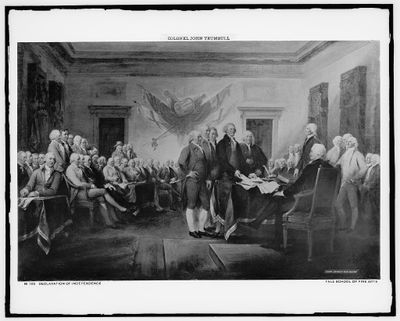This column reflects the opinion of the writer. Learn about the differences between a news story and an opinion column.
Think you know your Independence Day history? Can you answer these 13 questions?

Think you’re a true red, white and blue American because you know all the words to the Pledge of Allegiance, most of the words to the Star-Spangled Banner and put out your flag once a year?
Then it’s time for you to check your Yankee Doodle Dandy-ness with our annual Fourth of July Trivia Quiz. As usual, there are 13 questions, one for each original colony. Check your answers then compare scores with good patriots at an upcoming barbecue.
1. By shooting off fireworks on July 4 to mark a big event, Americans are participating in a tradition that probably started in
A. China
B. India
C. Egypt
D. Italy
2. Which of the following was not one of the 13 original colonies?
A. New Hampshire
B. New Jersey
C. Georgia
D. Alabama
3. Where was the Second Continental Congress meeting when it declared independence from Great Britain?
A. New York
B. Philadelphia
C. Boston
D. Trenton, New Jersey
4. July Fourth is also called Independence Day because
A. That’s the day the American Revolution started
B. That’s the day the Continental Congress voted for independence from Great Britain.
C. That’s the day the Continental Congress approved the Declaration of Independence.
D. That’s the day the Treaty of Paris was signed ending the American Revolution.
5. During the American Revolution, who proclaimed, “I have not yet begun to fight.”
A. George Washington
B. Patrick Henry
C. John Paul Jones
D. Benedict Arnold
6. The flag proclaiming “AN APPEAL TO HEAVEN,” which recently gained some notoriety by flying over a Supreme Court justice’s summer home, was used by some American naval ships during the revolution. Besides the slogan, what is on the flag?
A. A coiled snake
B. A segmented snake
C. A circle of 13 stars
D. A pine tree
7. The Declaration of Independence has a list of grievances against the king of England. Who was that king?
A. George I
B. George II
C. George III
D. George IV
8. As commander-in-chief of the Continental Army, George Washington ordered his troops to be inoculated against
A. Yellow fever
B. Small pox
C. Malaria
D. Cholera
9. What Southern city refused to celebrate July Fourth for 81 years after the Civil War?
A. Richmond, Virginia
B. Vicksburg, Mississippi
C. Atlanta
D. Chattanooga, Tennessee
10. In the Declaration of Independence, Thomas Jefferson wrote the three unalienable rights are “life, liberty and the pursuit of happiness.” In doing so, he was changing the writings of John Locke, who listed those rights as “life, liberty and …”
A. Safety
B. Health
C. Sustenance
D. Property
11. How many people signed both the Declaration of Independence and the Constitution?
A. 2
B. 4
C. 6
D. 10
12. During the War of 1812 when the British were burning Washington, D.C., who is credited with saving the original copy of the Declaration of Independence?
A. Andrew Jackson
B. Dolly Madison
C. Thomas Jefferson
D. Abigail Adams
13. Who was the first president to celebrate July Fourth at the White House?
A. George Washington
B. John Adams
C. Thomas Jefferson
D. James Monroe
Answers
1. A. Most traditions say gunpowder was invented in China and the Chinese were the first to use it in fireworks.
2. D. Alabama wasn’t admitted to the union until 1819.
3. B. Philadelphia was the colonies’ largest city, as well as being somewhat centrally located.
4. C. The Continental Congress voted for independence on July 2 but didn’t approve the wording of the declaration until two days later.
5. C. John Paul Jones, as commander of the Bonhomme Richard, was said to have given this as a demand to surrender in a 1779 battle with a British warship.
6. D. The flag has a white background with a green pine tree.
7. C. George III, who was one of Great Britain’s longest reigning monarchs, was also king during the War of 1812.
8. B. Smallpox was a major problem in the colonies. In 1777, Washington ordered the Continental Army to be inoculated against the disease through a process that involved making a small cut in a healthy person’s arm and exposing it to pus from an infected person.
9. B. Vicksburg, Mississippi, surrendered to Gen. Ulysses Grant on July 4, 1863, after a long siege, and didn’t celebrate Independence Day again until 1944.
10. D. Property. Pursuit of happiness is not mentioned in the Constitution, although protections of life, liberty and property are listed in two amendments.
11. C. The six were Benjamin Franklin, Roger Sherman, George Clymer, Robert Morris, James Wilson and George Read.
12. B. First Lady Dolly Madison was credited with saving the Declaration and a painting of George Washington, after her husband reportedly fled the city.
13. C. Jefferson. The executive mansion, as it was called, wasn’t finished until fall of 1800, so the first occupants, John and Abigail Adams, didn’t have a chance to celebrate it there.
Score
0-3 Union Jack
4-6 Not-so-Dandy Yankee Doodle
7-11 Minute person
12-13 Founding Father or Mother